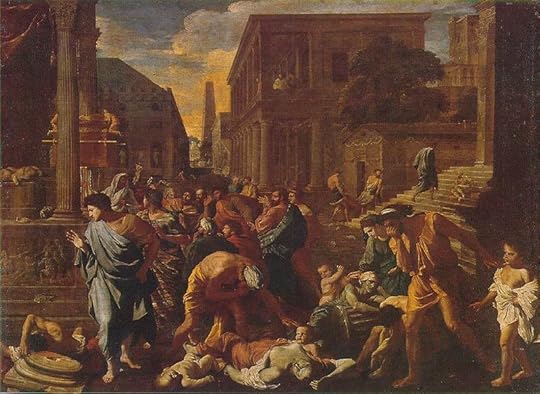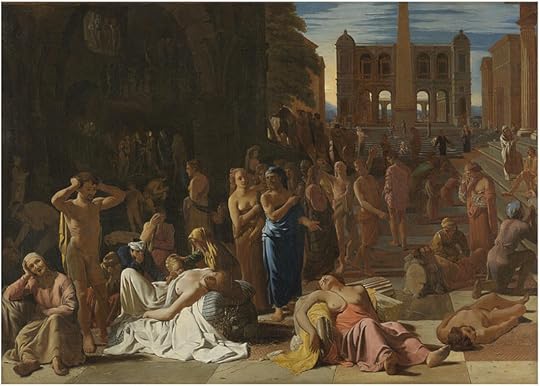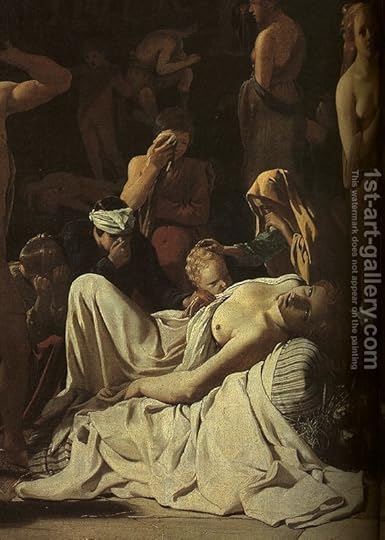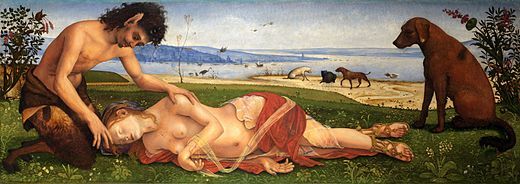 Kalliope’s
Comments
(group member since Aug 28, 2018)
Kalliope’s
Comments
(group member since Aug 28, 2018)
Kalliope’s
comments
from the Ovid's Metamorphoses and Further Metamorphoses group.
Showing 161-180 of 610
 Then there is this Poussin, but it is not the Athenian plague, but comes from the Old Testament, the Plague at Ashdod.
Then there is this Poussin, but it is not the Athenian plague, but comes from the Old Testament, the Plague at Ashdod.Nicolas Poussin. The Plague at Ashdod, 1630. Louvre.

 I have found an interesting painting on the Athenian Plague, by Michiel Sweerts and workshop. I am not very familiar with this painter, except that one of his pieces is a favourite of mine in the Thyssen.
I have found an interesting painting on the Athenian Plague, by Michiel Sweerts and workshop. I am not very familiar with this painter, except that one of his pieces is a favourite of mine in the Thyssen. Michiel Sweerts. Plague in an Ancient City. 1652-54. Private collection.

And a detail.

 My notes comment on the various sources for The Plague.
My notes comment on the various sources for The Plague. As HG has pointed out, the main is Thucydides .. who, in his history of the Peloponnesian War gives and eyewitness report of a historical plague at Athens in 430BC as a survivor of that epidemic and describes it and its social effects with clinical detachment.
Then there is the 1stC BC Roman poet Lucretius who gives a poetical version very much based on Thucydides in his De Rerum Natura, Vol 1. Virgil also gives an account in his 'Noricum'.
It seems the main sources for Ovid would have been Thucydides and Lucretius.
What Ovid does that is strange is that he mixes the embedded narrative with an eye-witness narration. He is playing with the boundaries of the narrative that make the reader dizzy. I think RC had pointed this out in earlier examples.
 In terms of paintings, the whole section of Aegeus-Theseus-Minos-Androgeos-Aeaus-Cephalus-Phocus-Procris, and the Plague, is again a complex episode for, I think, a couple of main reasons. Ovid assumes the reader knows more than (at least I) his much later readers know. And second for again using the multilayered narrative stories. The embedded stories always make me feel I am falling through a spiral (and that supposedly should make me feel comfortable).
In terms of paintings, the whole section of Aegeus-Theseus-Minos-Androgeos-Aeaus-Cephalus-Phocus-Procris, and the Plague, is again a complex episode for, I think, a couple of main reasons. Ovid assumes the reader knows more than (at least I) his much later readers know. And second for again using the multilayered narrative stories. The embedded stories always make me feel I am falling through a spiral (and that supposedly should make me feel comfortable).
 Peter wrote: "Historygirl wrote: "The most recent New Yorker (April 1, 2019) published a wonderful poem entitled Daphne by Carol Muske-Dukes that includes an Ovid quote. The poet conveys the complexity about lov..."
Peter wrote: "Historygirl wrote: "The most recent New Yorker (April 1, 2019) published a wonderful poem entitled Daphne by Carol Muske-Dukes that includes an Ovid quote. The poet conveys the complexity about lov..."Lovely transcription, Peter.
 Historygirl wrote: "The most recent New Yorker (April 1, 2019) published a wonderful poem entitled Daphne by Carol Muske-Dukes that includes an Ovid quote. The poet conveys the complexity about love that Ovid captures..."
Historygirl wrote: "The most recent New Yorker (April 1, 2019) published a wonderful poem entitled Daphne by Carol Muske-Dukes that includes an Ovid quote. The poet conveys the complexity about love that Ovid captures..."I echo (!) Peter in his thanking you for this poem, HG.
 Elena wrote: "My friend Cynthia Haven of the Book Haven blog went to Mary Zimmerman's production of the Met both in New York, years ago, and in Berkeley recently. The photos show how Zimmerman captures that enga..."
Elena wrote: "My friend Cynthia Haven of the Book Haven blog went to Mary Zimmerman's production of the Met both in New York, years ago, and in Berkeley recently. The photos show how Zimmerman captures that enga..."I would have loved to have gone back to Berkeley for this.
The water on stage makes me think of a very different opera, Debussy's 'Pelleas' which I saw a few years ago in Berlin. They also used this with a very striking effect.
 Last Monday I went to see Cavalli's opera "La Calisto".
Last Monday I went to see Cavalli's opera "La Calisto".It was wonderful. Much better than expected. The production - the costumes, the characterisation etc... were extraordinary. Very creative and very funny.
 Elena wrote: "On to Procris and Cephalus, there are wonderful interactions between the interpretations in Italian theater and painting, a play by Correggio and paintings by Luini. The pathetic Greek style melodr..."
Elena wrote: "On to Procris and Cephalus, there are wonderful interactions between the interpretations in Italian theater and painting, a play by Correggio and paintings by Luini. The pathetic Greek style melodr..."I will read this article during the weekend, Elena. Thanks for sharing. I am particularly interested because it probably has a link with something I have just read in the The National Gallery Companion Guide: Revised and Expanded Edition
I have come in the Guide to this painting by Piero di Cosimo. "A Satyr mourning over a Nymph", about 1495.

Looking at it I would not have thought it was about Procris, but the text that comments on the painting, after summarising the Cephalus & Procris story says:
...The dog by her side may be the hound which she had also given to Cephalus. The mourning satyr, half-goat half man, is not mentioned by Ovid but is included in a 15C play on this theme.
May be RC has more to comment on this.
 Historygirl wrote: "Ovid tells another story, the Plague, that was common knowledge based on what is believed to be an actual event in Ancient Greek history. Here, as in the case of Medea, he needed a new viewpoint an..."
Historygirl wrote: "Ovid tells another story, the Plague, that was common knowledge based on what is believed to be an actual event in Ancient Greek history. Here, as in the case of Medea, he needed a new viewpoint an..."Fascinating comparison, Historygirl.
I still have the last section of this Book to read closely (my second reading). I will look for any possible paintings on this.
 Roman Clodia wrote: "Yes, and isn't Tereus' lack of moral conflict part of our indictment against him. Whereas Medea is made more human and empathetic precisely because we get to see/share her conflicts. ..."
Roman Clodia wrote: "Yes, and isn't Tereus' lack of moral conflict part of our indictment against him. Whereas Medea is made more human and empathetic precisely because we get to see/share her conflicts. ..."Absolutely... I have found it so fascinating.. After getting used to seeing that speech was taken away from raped women I certainly welcomed getting into the mind of another woman whose inner dialogue had plenty of room....
 Medea escapes hidden in a cloud...
Medea escapes hidden in a cloud...I ought to have counted the number of times characters hide in clouds.. I think the first was Jupiter when he seduced Io.
 Moving onto the Theseus story I recall the couple of novels written on this by Mary Renault.
Moving onto the Theseus story I recall the couple of novels written on this by Mary Renault.The King Must Die and The Bull from the Sea
These fit in this group, together with The Golden Fleece as Metamorphoses on the Metamorphoses although neither Graves nor Renault have used only Ovid. Neither are source texts, of course.
 Thinking again on the Medea section, I have enjoyed reading the episodes in her life with which I was unfamiliar, and am surprised at the few lines devoted to the episode in both Euripides's and Seneca's plays.
Thinking again on the Medea section, I have enjoyed reading the episodes in her life with which I was unfamiliar, and am surprised at the few lines devoted to the episode in both Euripides's and Seneca's plays. And Jason, such a hero in Colchis, disappears from the foreground as the story.. Again, we are not told that he takes on another bride. Ovid tells stories to an audience/readership who already knows them.
 I am now reading the excellent notes to this Book in my edition.
I am now reading the excellent notes to this Book in my edition.Medea's soliloquy is identified as 'the first true account of the genesis of love'. We shall encounter others in Books 8 (Scylla); 9 (Byblis); 10 (Myrrha); and 10 (Atalanta).
The one other character subjected to a passion (Tereus - Book 6) but he was not subjected to self-doubt. There was no moral conflict.
This for me now rings very close to my 'reading skin' because I am currently also dealing with Dostoyevsky... haha..
 Searching more on Pelias, I've found this striking staging.
Searching more on Pelias, I've found this striking staging.I am unfamiliar with the painter.
Georges Moreau de Tours. The Murder of Pelias by His Daughters. 1870.

 Jim wrote: "There seem to be so many variations on the Medea story (along with the fact that Ovid omits so many important points) that I'm inclined to go looking for another account of it. But I'm afraid it wo..."
Jim wrote: "There seem to be so many variations on the Medea story (along with the fact that Ovid omits so many important points) that I'm inclined to go looking for another account of it. But I'm afraid it wo..."From what I remember the entasis of the book was on the whole trip going to Colchis, rather than on Medea. That's why I have found this account somewhat perplexing because we almost start with Colchis, and then it is later, with the revenge on Pelias, that we learn more of the origin of the trip in search of the Golden Fleece (well, the origins are not really told by Ovid - they are just alluded to -- another instance of his assuming that his readers are already familiar with his stories.
 Peter wrote: "One more painting on the typic of Apollo and Marsyas that I found in the online collections of the Saint Louis Art Museum.
Peter wrote: "One more painting on the typic of Apollo and Marsyas that I found in the online collections of the Saint Louis Art Museum."
This is a great find, Peter. Thank you. Showing the beginning of the scene it is not as gory... Marsyas's body can still be displayed in it undamaged beauty.
 Philip the Good, Duke of Burgundy founded the Order of the Golden Fleece in the first half of the 15C.
Philip the Good, Duke of Burgundy founded the Order of the Golden Fleece in the first half of the 15C.

